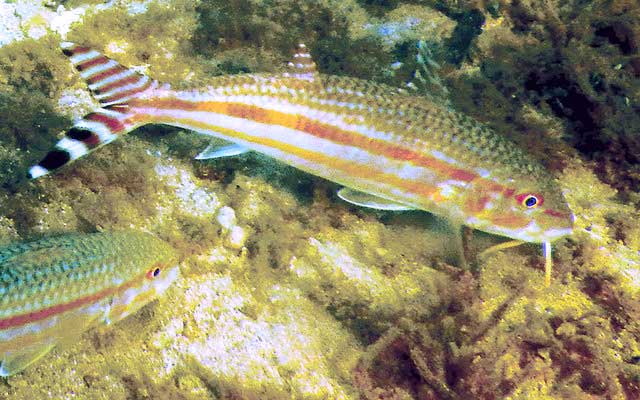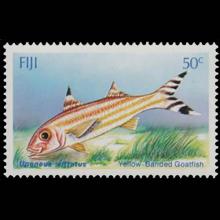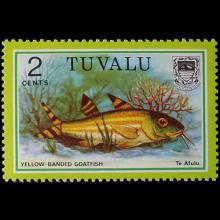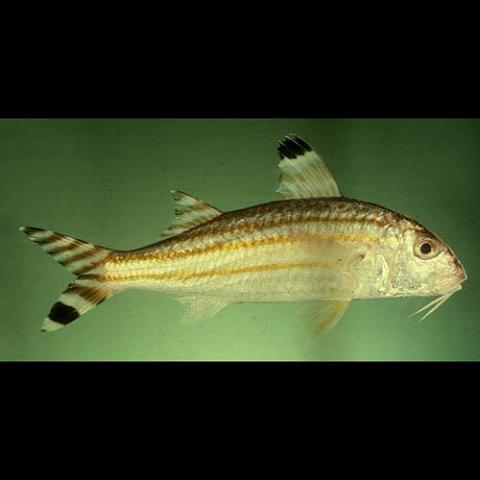NAMES
TAXONOMY
Fiji
Issued:
Stamp:
Upeneus vittatus
Tuvalu
Issued:
Stamp:
Upeneus vittatus
Fiji
Issued:
Stamp:
Upeneus vittatus
Tuvalu
Issued:
Stamp:
Upeneus vittatus
Fiji
Issued:
Stamp:
Upeneus vittatus
Tuvalu
Issued:
Stamp:
Upeneus vittatus
Hallucinations from toxin in fish are rare but potent
by Susan Scott, July 23, 2016

A Kentucky man emailed that he was doing research on nightmare weke and wondered whether I knew of recent cases here. Because I hadn’t written about this odd illness, also called hallucinatory fish poisoning, for years, I wondered, too.
The term nightmare weke makes it sound as if only goatfish carry this poison. But the rare toxin, origin unknown, is found throughout tropical and temperate waters. Other culprits include convict tangs (manini), chubs (nenue), mullets (ama), coral groupers and rabbitfish (the latter two not found in Hawaii).
In the Mediterranean and eastern Atlantic, the common food fish saupe, or sea bream, has caused hallucinatory fish poisoning. In Arabic the sea bream is known as “the fish that makes dreams.”
Reunion Islanders (Indian Ocean) call a rabbitfish “the fish that inebriates.” Hawaiians named the sometimes hallucinatory bandtail goatfish weke pahulu, meaning “king of ghosts.”
“Ghost” is putting it mildly. The visions that afflict people who eat affected fish are so dreadful, I get the creeps reading about them.
In 1994 a 40-year-old executive ate sea bream in Cannes, France. Severe vomiting that night caused the man to shorten his vacation and drive home. Soon he started hearing animals screaming and stopped when giant insects surrounded the car. After 36 hours in the hospital (with sedation, I hope), the man was fine.
Another Frenchman in 2002 ate sea bream he bought from a fish market. Because he was 90 and feared people would declare him senile, the man suffered terrifying hallucinations of humans screaming and birds shrieking. When the visions disappeared he reported the incident.
These report dates from a poison center in Marseilles show that the toxin is rare in France. It’s rare in Hawaii, too. From 1990 to 2014 the number of cases reported to the Department of Health was 17, the last one in 2011.
The unidentified toxin occurs in both carnivores and algae-eaters, usually in summer. Cooking doesn’t inactivate the poison, which seems to be concentrated in the head. One Hawaii blog offers good advice to mullet and goatfish fishers: “No eat da head.”
In a 1960 medical journal, researchers wrote that information about this syndrome was being suppressed because “Russia was exceedingly interested in nerve drugs such as this.”
I learned that my emailer’s research was not a scientific study as I thought. Rather, he was gathering material for a New York friend making a film about substances in nature that get people high.
You know it’s a crazy world when people consider poisoning themselves and others with a fish.
Report hallucinatory fish poisonings to the state Department of Health. Save the fish for testing.
Genus species (Animalia): Upeneus vittatus
Native Range: Indo-Pacific from South Africa and the Red Sea to Japan, New Caledonia, Micronesia, the Society Islands, and the Marquesas (Mundy 2005).
Description
Goatfishes are characterized by a pair of chin barbels (or "goatee"), which contain chemosensory organs and are used to probe the sand or holes in the reef for food. Their bodies are deep and elongated, with forked tails and widely separated dorsal fins. The first dorsal fin has 6-8 spines; the second dorsal has one spine and 8-9 soft rays, shorter than anal fin. Spines in anal fin 1 or 2, with 5-8 soft rays. They have 24 vertebrae.
Many goatfishes are brightly colored. The largest species, the dash-and-dot goatfish (Parupeneus barberinus), grows to 60 cm in length; most species are less than half this size. Within the family are six genera and about eighty-six species.
Toxicity
The unidentified toxin occurs in both carnivores and algae-eaters, usually in summer. Cooking doesn’t inactivate the poison, which seems to be concentrated in the head. One Hawaii blog offers good advice to mullet and goatfish fishers: “No eat da head.” Hawaiians named the sometimes hallucinatory bandtail goatfish weke pahulu, meaning “king of ghosts.”
Reference: www.usgs.gov, Staradvertiser.com



